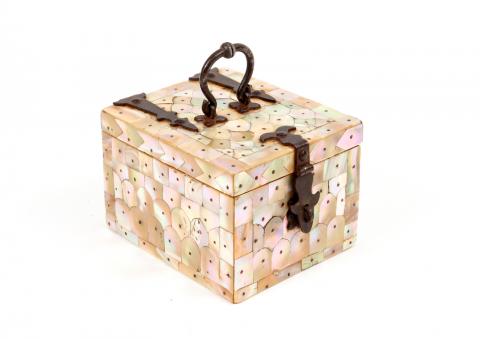Cofre
Small casket
India, Gujarat; 17th century
Mother-of-pearl and iron; iron fittings
Dim.: 8.2 x 10.0 x 11.8 cm
Pequeno cofre
Índia, Guzarate; século XVII
Madrepérola e ferro; ferragens de ferro
Dim.: 8,2 x 10,0 x 11,8 cm
This small casket, a rectangular box with a flat lid, is entirely made of mother-of-pearl tesserae fixed together in a double-walled construction using iron pins without any wooden core or structure. This makes it a rare example of this Gujarati production, where only complex objects such as water jugs and bottles follow this type of construction. The outer faces (front, back, sides, and lid) are decorated with a mosaic pattern of tesserae with simple scales framed with a border of rectangular tesserae; the sides of the lid have a braided-like frame. The mother-of-pearl used for the front, back, sides and lid are all from the shell of the marine gastropod Turbo marmoratus, the preferred material in this production for its high iridescence. In contrast, the interior sides and underside are entirely made from the shells of pearl oysters, probably that of Pinctada maxima given the dimensions and colour of the tesserae. This type of shell is generally only used in this production for the backs, underside and interior sides. The box is fitted with a wrought-iron Islamic-style lock plate, long hinges and a top handle. This box, albeit following the expected techniques and materials, including the high quality of the mother-of-pearl, uses iron instead of brass for pinning the tesserae. Nonetheless, Indian craftsmen are well known for their superior knowledge and techniques of mastering iron since earlier times. With its diminutive size and shape, the present casket is a new addition to the repertoire of known household Gujarati objects made from mother-of-pearl and must have been used to store valuable jewels and precious gemstones.
Hugo Miguel Crespo
Centre for History, University of Lisbon
Bibliography:
CRESPO, Hugo Miguel, India in Portugal. A Time of Artistic Confluence (cat.), Porto, Bluebook, 2021,
WILLS, Barbara, Susan La Niece, Bet McLeod, Caroline Cartwright, “A shell garniture from Gujarat, India in the British Museum”, The British Museum Technical Research Journal, 1 (2007), pp. 1-8
--
Este pequeno cofre de corpo paralelepipédico e tampa plana é integralmente composto por tesselas de madrepérola fixas entre si, em parede dupla, através de pinos de ferro e sem qualquer alma ou estrutura de madeira. Isto torna-o exemplar raro desta produção do Guzarate onde apenas objectos complexos tais como jarros de água e garrafas seguem este tipo de construção. As faces exteriores (frente, tardoz, ilhargas e tampa) são decoradas por mosaico em padrão de tesselas de escamas simples com emolduramentos de tesselas rectangulares; a cintura da tampa apresenta um friso espinhado.
A madrepérola usada na frente, tardoz, ilhargas e tampa tem toda origem no nácar da concha do gastrópode marinho Turbo marmoratus, muito apreciado nesta produção pelo elevado efeito de iridescência. Já o interior e fundo é todo de concha de ostra perlífera, provavelmente e dadas as dimensões e coloração, de Pinctada maxima, normalmente usada nesta produção para os tardozes, fundos ou interiores.
Este pequeno cofre apresenta ferragens de ferro forjado de tipo islâmico, e incluem o espelho da fechadura, as longas dobradiças e a alça da tampa.
Neste pequeno cofre, embora fazendo uso das usuais técnicas e materiais, incluindo a grande qualidade da madrepérola, pinos de ferro foram usados na sua construção ao invés do habitual latão. No entanto, os artífices indianos são famosos pelo seus conhecimentos superiores e técnicas ancestrais de trabalhar este material de forma magistral. Com as suas reduzidas dimensões e forma, este cofre é uma nova adição ao corpus de objectos do quotidiano feitos no Guzarate com madrepérola, tendo sido certamente utilizado para guardar jóias valiosas e gemas preciosas.
Hugo Miguel Crespo
Centro de História, Universidade de Lisboa
Bibliografia:
CRESPO, Hugo Miguel, A Índia em Portugal. Um Tempo de Confluências Artísticas (cat.), Porto, Bluebook, 2021,
WILLS, Barbara, Susan La Niece, Bet McLeod, Caroline Cartwright, “A shell garniture from Gujarat, India in the British Museum”, The British Museum Technical Research Journal, 1 (2007), pp. 1-8
- Arte Colonial e Oriental
- Artes Decorativas
- Marfim, Tartaruga e Madrepérola

